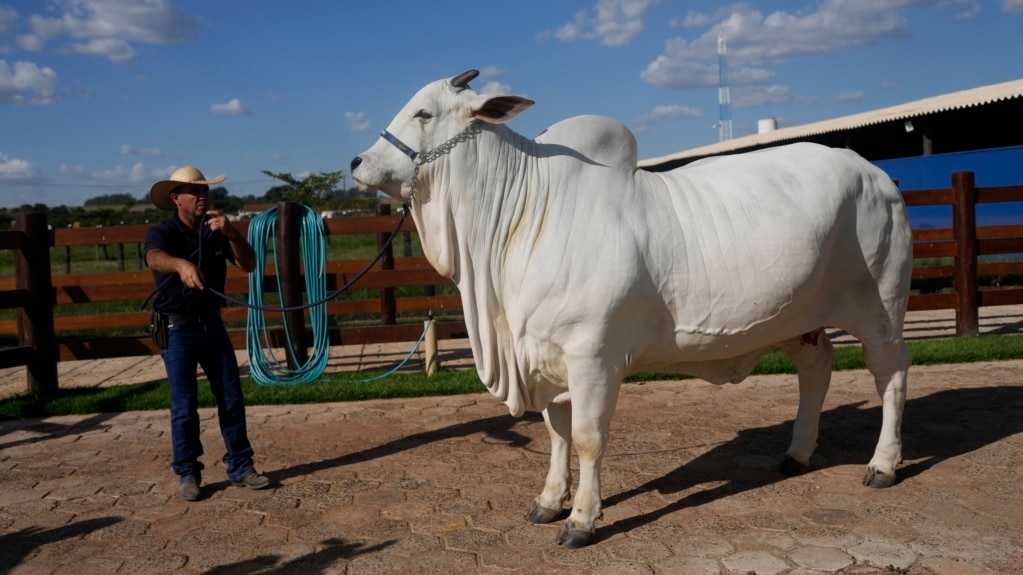The Brazilian ranchers who own the world’s most costly cow call her Viatina-19.
The large, white cow is valued at over $4 million. At 1,100 kilograms, she is about two times the weight of most cows of her kind.
Viatina-19 is protected by security cameras and a guard with a gun on the ranch in Uberaba, a town in the central Minas Gerais state. Her owners will not sell her for meat, but they hope Viatina-19 can be the start of a long line of “supercows.”
Those cows will go on to have calves, or baby cattle. As time goes by, many of Viatina-19’s relatives will be raised for meat.
Any rancher who wants to buy one of Viatina-19’s eggs must pay $250,000. They combine the egg with the reproductive cells, or sperm, of a top bull hoping the resulting animal will be the start of a ranch filled with valuable cattle.
Viatina-19 and the other cows and bulls are considered “elite,” or among the very best in the world. “We’re not slaughtering elite cattle. We’re breeding them. And at the end of the line, going to feed the whole world,” one of her owners, Ney Pereira, said.
Viatina-19 is elite because she quickly puts on muscle and size. Lorrany Martins is an animal doctor and Pereira’s daughter. She said many of the cows that have come from her genetic line have done the same.
Close to perfection
“She is the closest to perfection that has been attained so far,” she said.
Since the early 2000s, cattle ranching has grown into one of Brazil’s top industries. There is even a cow channel on the Globo television network. The nation carries out high-level research into the genetics of cattle and it does more in-vitro, or laboratory, fertilizations than any other country.
Viatina-19 is an example of Brazil’s success in the beef industry. She has three owners now. The most recent owner joined the other two at a cost of $1.3 million. Guinness World Records said that partial sale was the most ever for a cow.
About 80 percent of the cattle in Brazil are from the Zebus subspecies, a sort of cow that first came from India. Viatina-19 is part of the Nelore breed within the Zebus group. Most of the cows in Brazil are Nelore.
The cows from India came to Brazil in the late part of the 1800s. The cows did better in the hot climate than those who came from Europe.
Increased beef exports
Brazil exported more than 2 million tons of beef in both 2022 and 2023. Much of the beef goes to nations like China, whose economies have grown in recent years.
Agriculture and cattle ranching are important in Brazil. The country has 230 million cattle. President Luiz Inácio Lula da Silva wants new markets for his country’s products. Last month, he met with Japanese Prime Minister Fumio Kishida. Japan produces the famous Wagyu beef. But Lula invited the Japanese leader to taste Brazilian beef on his next visit.
In April, Lula’s tour of Brazilian beef continued. He visited one of the 38 meat processing centers in his country that are authorized by China. He said Brazil will bring in billions of dollars by selling beef to China.
Lula also said Brazil’s beef industry is free of foot-and-mouth disease, which affects cattle. The World Organization for Animal Health might recognize Brazil’s status in August.
‘Country’ culture
Every year, Uberaba has an event called ExpoZebu. It is the world’s largest festival for Zebu cattle. People wear clothes associated with rural America – baseball caps, boots and blue jeans. They listen to country music that started in the United States.
Ranchers come from all around the world, including Indonesia and Zimbabwe, for the cattle show. The biggest auction is Elo de Raça. This year, it took place on April 28. One rancher in attendance was Arthur Lira, a well-known congressman in Brazil. He planned to sell a 3-month-old calf.
He said the auctions “present the best of what each person has.” When the cows are sold, their genetics move around the country and around the world.
Some of the cows shown at the event are clones – that means they are genetic copies of other cows. One such cow is Donna. She was at the show with three clones. The four cows were purchased for $3 million because they produce so many eggs. The announcer called them “a factory.”
Genes and other concerns
Cows like Donna and Viatina-19 are cloned in a building not far from the auction area. Scientists take the cows’ DNA from their tail hair and use it to create genetic copies. The DNA is used to create embryos and they are put in the uteruses of surrogate mothers.
Paulo Cerantola is a director with a genetic company called Geneal Animal Genetics and Biotechnology. He said the surrogates are “rental bellies.” There are about 500 of them in a field.
Not all of the calves will survive, he said. Some will have to be killed because of genetic problems. Cerantola said clones of Viatina-19 are to be born soon.
Grant Vassberg is a rancher from Texas who has visited Brazilian auctions. He said even if the famous cows produce lots of children and lots of clones, there are problems. He said Viatina-19 is “poison for the industry.”
“We still need cows to be efficient on grass,” he said. “That’s how you feed the world.”
Pereira, however, said that Viatina-19 only gets special treatment to increase the production of egg cells. He said she would do well if she just lived like other cows.
Pereira and his daughter are still working to spread Viatina-19’s DNA around the world. Her egg cells have been sold to ranchers in Bolivia and he wants to sell them in the Middle East and the U.S.
“If she is the best in the world…we need to share her around the world,” he said.
I’m Dan Friedell.
And I'm Gena Bennett.

